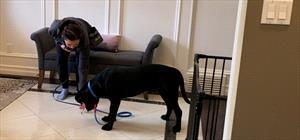Jumping Up! How to Help Your Pup
By Jessica Benoit, RVT, VTS (Behavior), KPA CTP, CPDT-KA, EFFCP; Courtesy of CattleDog Publishing

Jumping up on people is a troublesome behavior that happens when a dog is excited. People reinforce the behavior by petting and providing praise when the dog is happy to see them. Others scold or push the dog off, which can also reinforce this behavior. Conflicting interactions can make it difficult for your dog to understand what is expected. Jumping up is often tolerated or encouraged in small puppies but then discouraged once puppies have grown, causing confusion and frustration.
Manage the environment to prevent jumping by using barriers such as gates or crates. Leashes can be beneficial management tools to prevent jumping in the first place. A leash should not be used to pull or jerk your dog off someone; instead, use a food lure to move your dog off and away from the person. Call your dog and reinforce them for coming back to you.
When you know a guest will be arriving, have your dog behind a barrier to remove the opportunity to jump on them. Giving a food puzzle toy prior to the guest’s arrival can reinforce your dog for remaining behind the barrier. It keeps them engaged so they do not try to jump over the barrier or vocalize due to frustration. If this does occur, redirect your dog back to their food puzzle toy.
Set up training sessions to reinforce four paws on the floor as an alternative behavior to jumping. You will need:
easily accessible treats in a treat pouch or at a treat station near the front door;
your dog on a leash, kept loose throughout the session;
another person to help. Use different people in each training session to help generalize this behavior.
Training session example:
Phase 1: Start with your dog on a loose leash and place a treat on the ground while they keep four paws on the floor. Do this without the distraction of another person present. Keep the rate of reinforcement high by placing a treat on the ground every two to three seconds.
Phase 2: Enlist the help of someone your dog already knows to minimize excitement. While the helper stands still, place a treat on the ground every two to three seconds if the dog keeps four feet on the floor.
Phase 3: Have the helper move around. If this causes excitement for your dog, step away from the helper or ask the helper to move less until your dog can keep four paws on the floor. As you make it harder for your dog, the rate of reinforcement should remain high.
Phase 4: If your dog is successful, ask the helper to become more animated. This could mean removing their shoes and coat. Continue placing a treat on the ground every two to three seconds when your dog keeps four paws on the floor.
Phase 5: Have the helper slowly approach. This can be challenging if your dog loves to interact with people. Increase your reinforcement rate to every one to two seconds.
Phase 6: If you are concerned your dog may jump or if they get too excited and do jump, place a food treat near their nose and lure them away from the helper. At the next repetition, decrease the level of distraction.
When a guest arrives unexpectedly, grab a handful of treats from the treat station and scatter them on the ground. This encourages your dog to keep four paws on the floor while eating. Determine if they should remain near the guest or need to go behind the barrier.
This exercise can be used for greeting people on walks or in new environments. Your dog learns that people approaching or coming into the home is a cue for food on the floor. This builds a positive association with meeting new people and interacting properly while also encouraging the four paws on the floor behavior.







_edited.png)

